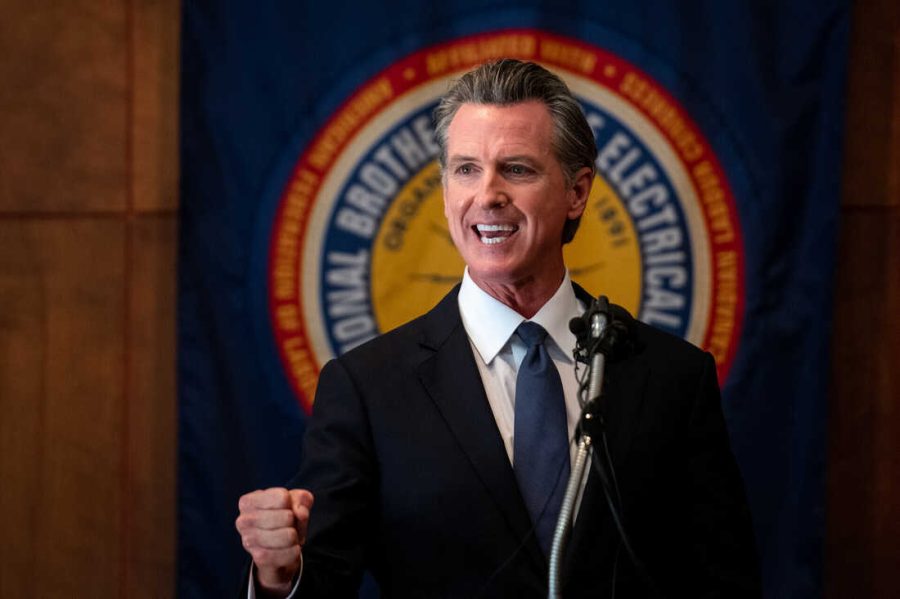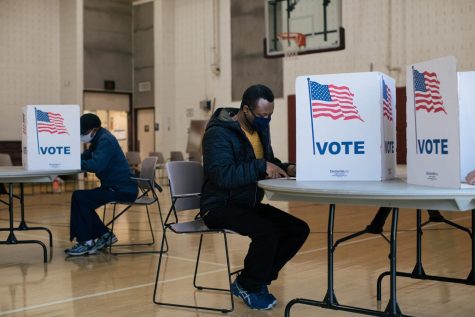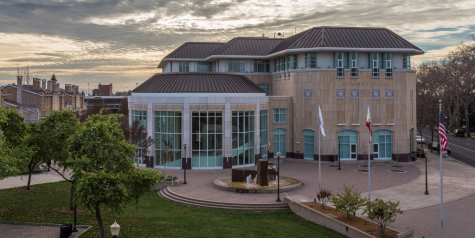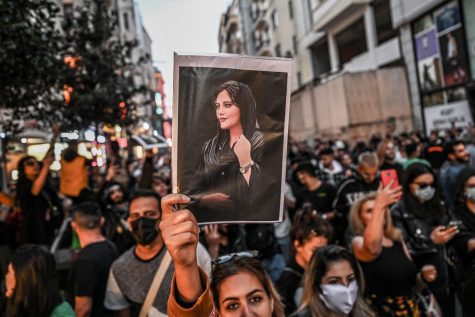Gov. Newsom: A Retrospective Piece
An overview on Newsom’s style of governance, new implementations, and recall response
California Gov. Gavin Newsom stops at IBEW Local 6 union hall in San Francisco on Sept. 14, 2021, to speak with union workers and volunteers.
July 14, 2022
Democratic Gov. Gavin Newsom has worked through a series of world crises throughout the past few years, a few of which include: massive budget issues, a housing shortage, constant and worsening wildfires, the COVID-19 pandemic that led to widespread school closures, teacher unions, and angry parents who needed their kids back in school. Newsom was also the first governor to experience a once-in-a-generation pandemic, issue lockdown orders, and implement a statewide mask mandate.
Though Newsom has remained fairly popular, a sizable population of Californians have been dissatisfied with his performance. Last year, a number of Conservative Californians banded together to collect signatures for recall petitions in order to remove Newsom from office. California’s attempt to recall Newsom, who was elected in 2018, failed and he will remain in office until at least 2023.
The main proponent of the recall effort, Orrin Heatlie said, “This is about Gavin Newsom and his failed policies that have put us in the state of despair we are in today.” Expressing similar distaste regarding Newsom’s political action, KQED’s Scott Shafer said, “Californians should sign petitions: due to the frustration over Newsom’s handling of the pandemic and business restrictions, rise in crime, worsening housing, homelessness crisis, high taxes, cost of living, and more.”
When the recall petitions were first underway, the COVID-19 pandemic and California’s handling of the health crisis were among one of the many reasons behind the movement. However, the COVID issue soon came to the forefront of public discourse after maskless Newsom attended a friend’s birthday party in Napa Valley amidst stay-at-home orders and other COVID-related restrictions. While an apology was issued on Newsom’s behalf, the incident was perceived by many voters as hypocritical, demonstrating that the Governor failed to practice what he preached.
In Sept. 2021, the incumbent Newsom was able to retain his governorship against 46 candidates, securing a 61.9% to 38.1% lead. Since the recall, many of Newsom’s progressive policies under the California Comeback Plan were signed and ratified, featuring immediate relief for families and small businesses, investment into affordable housing for targeted low-income and unhoused groups, expanding Pre-K and public school programs, increased financial aid for Californians in the CSU and UC systems, infrastructure upgrades, and climate change response via disaster preparedness and electric vehicle subsidies.
“In partnership with the Legislature, we have advanced hundreds of new bills this year to make meaningful progress on an array of issues that matter deeply to Californians across the state,” said Newsom at a Press Conference on Oct. 14. New laws and ideas under Newsom included:
- A $308 billion state budget that provides direct tax refunds for 23 million Californians to help address rising costs, tackles the state’s most pressing needs, builds our reserves, and invests in California’s future;
- Legislation to help protect patients and healthcare providers in California against attempts by other states to extend their anti-abortion laws into California;
- A bill, making ethnic studies a high school graduation requirement. Additionally, California State University students are required to take an ethnic studies course to graduate;
- Mandated mental health instruction in middle and high schools with an existing health education course;
- A requirement for universities to provide free menstrual products on campus;
- A bill, that ensures police can’t block journalists from covering protests and demonstrations;
- A bill extending a phone tax to fund high-speed internet in underserved areas;
- A historic $37.6 billion climate package to protect all Californians from the costs and impacts of climate change, while accelerating efforts to reduce the dependence on big polluters and fossil fuels.
Dr. Kim Geron, CSUEB’s Professor Emeritus for the Department of Political Science, is confident with the work Newsom is doing now: “Right now, when there are more resources, we can help fund healthcare and climate change. Since taxpayers gave so much money to the government, it is great that Newsom is giving back to the people who pay taxes which all represents how popular he is and his actions will be well received.”
To stay updated on California policies, laws, and news on Gov. Newsom, please visit.
















